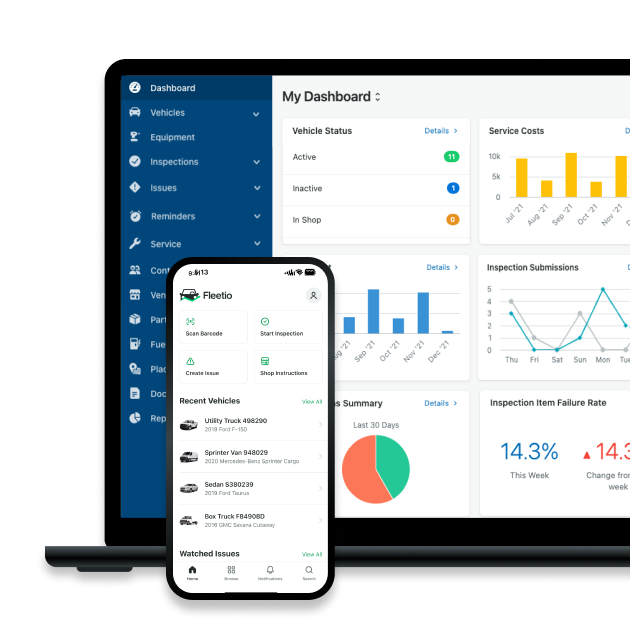Tire Inspections: How to Inspect Tires & Prevent Issues
We all know how to spot a bald tire or diagnose the meaning of a tire pressure warning light. But there’s a lot more involved in conducting a thorough tire inspection than you might think.
Aug 16, 2024
8 min read

Between complying with federal and state mandates, maximizing fuel economy, and (most importantly) looking out for the safety of their drivers, fleets have plenty of reasons to inspect their tires. But despite the fact that most fleets make a point of assessing the condition of their assets’ tires on a regular basis, faulty tires consistently rank among the most common violations found by the Federal Motor Carrier Safety Administration. This paradoxical situation might indicate that, while fleets almost universally inspect their tires, many don’t do so very thoroughly.
To help fleets better ensure the health of their tires, here’s what to look for when conducting tire inspections.
What to look for when inspecting tires:
- Proper tire pressure - Automakers recommend their vehicles be equipped with tires at specific PSI levels. Follow their guidance to maximize fuel efficiency, tire life and ride comfort.
- Compliant tread depth - While states have individual regulations, federal standards require tread depths of 4/32" and deeper for steering tires and 2/32" and deeper for non-steering tires.
- Even wear across the tire - If a tire seems to be degrading faster in certain spots, that could be a symptom of misalignment, improper inflation or bad suspension.
- Foreign objects lodged in the tire - Ensure nothing is embedded in your tires to avoid punctures from road debris.
- Rubber condition - Cuts, air bubbles and other defects are often signs that a tire needs to be replaced.
An app to surface critical tire information
With "tire reading" inspection items, fleets can gather tread depth and tire pressure as a standard item in pre-trip inspections. Catch potential blowouts before the rubber hits the road.
See how it works1. Tire pressure
These days, most modern vehicles come equipped with indirect tire-pressure monitoring systems (TPMSs) that notify drivers when a vehicle’s tires might be underinflated (typically via a dashboard light). While undeniably valuable, TPMSs shouldn’t be relied on in lieu of regular tire pressure measurements. In fact, indirect TPMSs are a bit of a misnomer because they don’t actually track tire pressure.
Instead, they use wheel speed sensors to detect if a tire’s revolution rate is out of sync with its counterparts (a strong indicator of underinflation). This means that if a vehicle’s tires deflate at a similar enough rate, an indirect TPMS might not detect any underinflation for quite some time.
Additionally, most TPMSs don’t factor in heavy loads when assessing whether a vehicle’s tires are properly inflated for a haul. If your fleet regularly moves weighty cargo, frequent tire pressure readings are especially important.
To check a tire’s pressure optimally, test it after it’s been parked for about three hours or more. Manufacturers provide recommended pounds per square inch (PSI) levels for “cold” tires and heat from driving can temporarily increase PSI by upwards of 6 pounds, so this approach is recommended whenever possible. You can find these manufacturer-suggested PSI levels in the door jamb of your vehicles, in their owner’s manuals or online.
Both underinflation and overinflation can cause tires to wear prematurely, so organizations should measure the PSI of every tire within their fleet at least once a month. Given how effective even the cheapest tire pressure gauges are and how quickly readings take, there’s no excuse for fleets to skip such an important maintenance procedure.
2. Tread depth
Tire treads are vitally important to the safety of any vehicle with wheels. By gripping the road, they provide traction that helps vehicles maintain greater control when rounding corners, accelerate more smoothly and brake more immediately. And in rainy weather, tire grooves expel water from beneath tires to maximize pavement contact, which prevents hydroplaning.
In fact, tire treads are so essential to the safe operation of vehicles that the Department of Transportation has specific requirements for the tires of commercial vehicles. As mandated by federal law, any tire attached to the front wheels of any bus, truck or truck tractor has to have a tread depth of at least 4/32 of an inch. All other tires are required to have a minimum tread depth of 2/32 of an inch.
To ensure compliance with federal and state regulations, fleets should measure the tread depth of their tires on a regular basis. Once a month is the standard rule of thumb, but consider checking on a more frequent cadence if your vehicles consistently travel long distances.
Whether your drivers and technicians use a tread depth gauge or the classic penny test, it’s crucial that they check every tire installed on your vehicles and that they perform depth measurements in several places on each tire. Even if a tire’s treads are mostly deeper than 2/32 of an inch, if any point reaches below that point, the integrity of that entire tire has been compromised. So to ensure tread measurements are as comprehensive as possible, it’s a good idea for fleet personnel to specifically measure parts of a tire that seem particularly worn down.
Did you know?
When it comes to safety behind the wheel, mere fractions of an inch of tread depth can make a huge difference. Hunter Engineering Company found that tires with a tread depth of 6/32" managed to stop 100 feet earlier than tires with a tread depth of 2/32" when driving at 60 miles per hour on a wet road.
3. Uneven wear
Under normal circumstances, tires should wear down in a mostly uniform manner with tread depth being nearly the same wherever you measure. But if a tire is poorly aligned, installed to a degraded suspension system, or over/underinflated, it's likely to make contact with road surfaces in unintended ways that concentrate friction to particular parts of its tread. This uneven distribution of wear can create weak points in tires that lead to failures far earlier than usual.
To verify that your tires aren't wearing down unevenly, examine as much of the tire tread as you can when conducting a tire inspection. If you find areas that seem more degraded than average, perform a tread depth measurement at those points to verify your suspicions. Should you confirm that the tire is wearing down faster in certain regions, check to see when its associated vehicle last received a tire alignment or had its suspension system inspected. In many cases, correcting faulty alignment and suspension issues can save you a considerable amount in tire-related expenses.
4. Foreign objects
Whether your fleet sticks to city streets or regularly travels on dirt roads, your vehicles’ tires endure a lot. Gravel, tiny bits of pavement and all kinds of miscellaneous debris constantly barrage your tires from every angle, and, over time, they can sometimes lodge themselves into your tires' treads and walls. And when they do, these foreign objects can throw off the balance of your tires and accelerate the degradation process.
When conducting a tire inspection, keep an eye out for anything that doesn't belong clinging to or embedded in your tires' treads and walls. While tiny pieces of gravel can often be swept off with little issue, things like nails and screws almost always require repair work or replacing the tire altogether.
Keep tabs on your fleet’s tires
Tires play a pivotal role in keeping your vehicles reliable, fuel-efficient and safe. With Fleetio, you can track the location, condition and use of every tire you own.
Learn moreA note about tire mileage and age
Finally, it’s also worth noting that it’s wise for fleets to track the mileage and age of the individual tires equipped to their assets. While these details aren’t necessary for drivers to record as part of their day-to-day inspections, having such information on hand can help provide a complete picture of where a tire is in its lifespan.
It’s fairly common for tires installed to assets that see limited or low-intensity use to show only minimal signs of wear for several years (or longer). But once enough years pass, even if they seem fine to the human eye, they still become worth replacing as a matter of fleet safety. By tracking the age of individual tires, the process of identifying old tires in need of disposal is simple and straightforward. Tracking the mileage of individual tires is similarly beneficial.
Tire management software
Tire management software can help fleets keep track of their tires’ age, mileage and more. Comprehensive visibility over your fleet’s tires and tire-related maintenance activities allows organizations to ensure your vehicles are always equipped with tires up to their standards. And by analyzing your tire data through customizable reports, fleets can gain insights to help you learn how to maintain tires most effectively.
And for added convenience, when you implement a tire inspection system that’s fully integrated with your fleet maintenance software, you can manage all micro- and macro-level aspects of keeping your vehicles at their best from a single centralized platform. Tire management solutions also pair well with a compatible parts management system to make tracking tire inventory a breeze.
Discover why fleets choose Fleetio
Thousands of organizations across countless industries rely on Fleetio to manage their fleet activities. No matter the size of your fleet, Fleetio can help you track, analyze and improve your operations.
Sign up for a free trial
Fleet Content Specialist
Through interviews, blog posts and webinars, Alex covers the tactics and technologies exceptional fleet managers use to achieve results. By sharing their success stories, his work aims to inform and inspire fleet professionals of all stripes.
LinkedIn|View articles by Alex BorgReady to get started?
Join thousands of satisfied customers using Fleetio
Questions? Call us at 1-800-975-5304
Get Our Newsletter
Join a community of 70,000+ fleet industry professionals.


